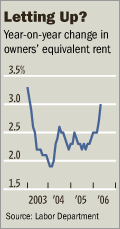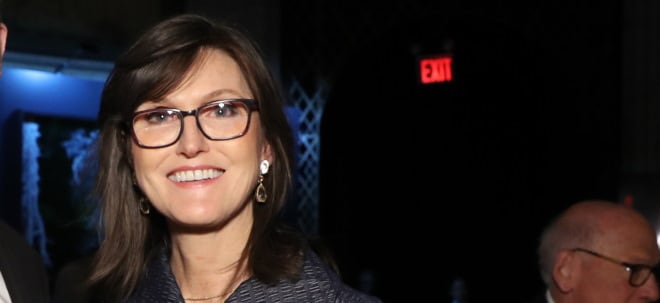Damit geht hier sogar eine Schere auf, bei der ein gewaltiger Nachfragedruck auf billige Mietwohnungen entsteht ... Inflationswirksam sind aber in erster Linie nicht die Käufe, sondern die Mieten."
Obwohl die Mehrzahl der Amerikaner in den eigenen vier Wänden wohnen, gibt es bei der Berechnung der Inflation (via CPI-Zahlen) ein Artefakt - die so genannte "Owners' equivalent rent" (OER). Dabei wird so getan, als würden alle Amis zur Miete wohnen. Es wird also eine "virtuelle Miete" angesetzt, die man bezahlen müsste, wenn man das Haus, in dem man wohnt, nicht besäße, sondern darin zur Miete wohnte. Diese OER-Zahlen fließen zu 40 % (!) in die Kern-CPI-Zahlen ein, aus denen die (Kern-)Inflation berechnet wird. OER ist also bei der Inflations-Berechnung ein wahres Schwergewicht.
Dies führte zu der paradoxen Situation, dass die Inflation SANK, als die Hauspreise explodierten. Grund: Da immer mehr Leute Häuser kauften, sank die reale Nachfrage nach Mietwohnungen, was auf die OER-Zahlen drückte und eine künstlich niedrige Inflation signalisierte, OBWOHL die steigenden Haus-Preise ja Teil der allg. Asset-Blase und der "schleichenden Vermögenspreis-Inflation" waren.
Nun, in der Housing-Krise, ist der Effekt umgekehrt. Immer mehr Leute (die ihr Haus verlieren z. B.) werden zu realen Mietern, was die Mieten auf Grund steigender Nachfrage erhöht und damit auch die OER-Zahlen steigen lässt. Daher steigen jetzt auch die offiziellen Inflationszahlen (siehe Chart der OER unten).
Dass passt den US-Inflations-Jongleuren natürlich nicht ins Konzept. Daher wurde im Mai 2006 ernsthaft diskutiert, die OER aus der Berechnung der Kern-Inflation rauszunehmen!
Motto: Verzerrungen zu unseren Gunsten nehmen wir gern in Kauf. Wenn sie aber gegen uns laufen, müssen wir uns Gedanken machen, dass die OER nicht überhaupt ein unrealistisches Konzept ist...
Wednesday, May 17, 2006
CPI and Owner's Equivalent Rent
MarketWatch has the story: Housing slowdown behind rise in inflation
Beneath the surface of rising core consumer prices over the past two months lies a disturbing trend: The slowing housing market is actually making inflation look worse, economists said.
The housing sector makes up 40% of the consumer price index, which increased 0.6% in April.
...
In the heady days of the booming housing market, more people were buying homes, and fewer were renting, economists said. Supply and demand kept rents comparatively low, and inflation appeared to be contained -- despite the run-up in home prices. But this virtuous circle is now reversing.
With home prices remaining high and mortgage rates rising, more people are being priced out of the real-estate market and are instead looking to rent. This increased demand is pushing up rents.
...
At the same time, the supply of rental properties has been constrained, as many former rental properties have been converted into condominiums, said Mark Vitner, senior economist at Wachovia Corp.
"This dynamic, once it begins, is fairly sticky," said John Ryding, chief U.S. economist at Bear Stearns. "This raises the risk of higher inflation going forward."
Perversely, this slowdown in the market is also pushing up the costs of owning a home, at least, the cost as reported by the government.
The way the government computes the CPI has created a distortion that made inflation look tame when home prices were soaring, but is now making inflation look worse as price gains moderate. It's all because the government measures everyone's housing costs -- renters and homeowners by looking at rents, not at the cost of owning.
Barry Ritholtz Blog
Owners' Equivalent Rent and Inflation
Monday, May 22, 2006
Over the weekend, we discussed the various "shills and montebanks are coming out of the woodwork to proclaim -- once again -- that there is no inflation, due to OER."
Today's WSJ looks at that exact issue, and to Justin Lahart's credit, avoids the trap:
..."In other words, a hot housing market perversely depressed official inflation measures, and now a cooling housing market is pushing those measures up. Some bond investors are prepared to dismiss the statistical gymnastics. But Barclays economist Dean Maki says that would be a mistake. Price figures are simply getting back to normal after being unnaturally low for a long time, he says. It would be somewhat disingenuous for policymakers to strip out owners' equivalent rent now, when they weren't stripping it out before when it was keeping core inflation low," he says."
Disingenuous is certainly the right word for it, and kudos to Dean Maki for recognizing that. Incidentally, the OER still understates inflation, as the chart at right reveals...
|
Angehängte Grafik:
oer_20060521171210.gif



 Thread abonnieren
Thread abonnieren


